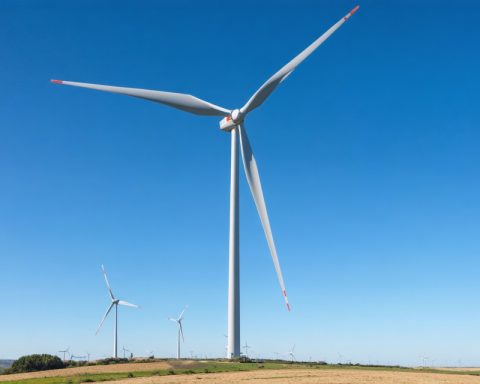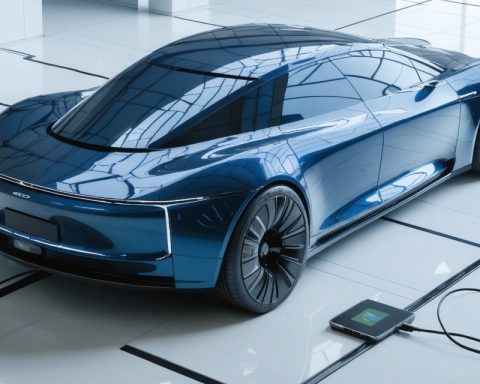- Azerbaijan is experiencing significant growth in its electric vehicle (EV) market, heavily influenced by Chinese manufacturers.
- Chinese models make up 77% of the 2,592 electric vehicles introduced in Azerbaijan last year.
- EV imports, including hybrids, reached over 15,000 units, valued at nearly $400 million, marking a substantial increase from previous years.
- BYD, a Chinese EV giant, is investing $17.1 million to build a production facility at Sumgayit Chemical Industrial Park, creating jobs for around 600 Azerbaijanis.
- Strategic alliances with China present opportunities for economic growth but also risk over-reliance on a single partner.
- Azerbaijan aims to develop a competitive local EV industry and diversify partnerships with European and South Korean players.
- The country is navigating toward a sustainable energy future, balancing collaboration, opportunity, and caution.
In a landscape once dominated by oil and gas, the soundtrack of Azerbaijan is rapidly shifting gears to the hushed, futuristic whirr of electric vehicles (EVs). Amidst this electrifying transformation, China emerges as the front-runner, steering Azerbaijan towards a modern automotive era dominated by clean energy.
As dawn breaks over the Caucasus, Azerbaijan’s streets hum with sleek electric buses, a significant portion of which hail from the industrial heartlands of China. With strategic investments and visionary alliances, China’s EV manufacturers are making bold inroads, claiming a significant foothold in Azerbaijan’s burgeoning market.
A glance at last year’s figures paints a vivid picture: of the 2,592 electric vehicles rolled into Azerbaijan, a staggering 77% were Chinese models. This influx is more than just cars and buses crossing borders; it signifies a comprehensive shift in Azerbaijan’s energy narrative. Imports of hybrid and electric vehicles soared to over 15,000, valued at nearly $400 million, dwarfed by the figures from just a year prior.
The roots of this green revolution stretch deep into Chinese soil, where giants like BYD leverage Azerbaijan not just as a market but as a regional conduit. It’s here that BYD envisions not only selling vehicles but crafting them. With an initial $17.1 million investment toward building a production facility in the Sumgayit Chemical Industrial Park, the ripples extend beyond environmental benefits—it promises economic rejuvenation and job creation for around 600 Azerbaijanis.
The strategic deployment of Chinese electric buses, evidenced by the pilot programs during last year’s COP29 environmental conference, underscores a dynamic bilateral partnership that transcends mere numbers. BYD’s plans to craft 500 buses annually, using locally sourced components for a significant portion of the production cost by 2030, are already in motion.
Yet, with opportunity comes a shadow of caution. Azerbaijan’s deepening entanglement with Chinese EVs risks evolving from partnership to reliance. Could the trailblazing investment lead to Azerbaijan becoming merely an assembly line in the grand blueprint of global trade?
For strategic thinkers in Baku, the path forward demands a delicate balancing act. China’s involvement must catalyze not just vehicle assembly, but the development of a robust, local industry—capable of rivaling the heavyweights on a global stage. There is also wisdom in diversification; nurturing alliances with European and South Korean EV pioneers might serve as a vital counterweight to Chinese influence.
Ultimately, the electric roads ahead are paved with both promise and precaution. If Azerbaijan can harness the power of collaboration equitably, the nation stands poised at the cusp of a sustainable energy frontier, ready to redefine its legacy not just within its borders but across Central Asia.
The Rise of Electric Vehicles in Azerbaijan: A Green Revolution with Lessons for the Future
A New Era for Azerbaijan’s Automotive Industry
Azerbaijan’s transition from traditional oil and gas to electric vehicles (EVs) marks a pivotal shift in its economic and environmental landscape. Chinese EV manufacturers such as BYD are at the forefront of this transformation, largely due to significant investments and strategic planning. Nearly 77% of the electric vehicles now traversing Azerbaijan’s roads are of Chinese origin, reflecting this strong bilateral relationship.
Key Insights: Why Are Chinese EVs So Dominant?
– Affordable and Reliable: Chinese EVs are renowned for their affordability combined with reliable performance, making them attractive to Azerbaijan’s growing market.
– Strategic Investments: China’s investment of $17.1 million in the Sumgayit Chemical Industrial Park signifies a long-term commitment to not only sell cars but also manufacture them, providing local employment for approximately 600 Azerbaijanis.
– Technological Advancements: Chinese EVs incorporate advanced technology and design, positioning them as leaders in the EV market.
Strategic Alliances and Industry Trends
The swift embrace of Chinese EVs suggests the potential for deeper economic ties, but Azerbaijan must carefully manage this dependency. Strategic diversification is crucial:
– Emerging Partnerships: Diversifying partnerships with European and South Korean EV manufacturers could mitigate over-reliance on Chinese technology and supply.
– Local Industry Development: Developing an independent local automotive industry will enhance Azerbaijan’s capacity to compete globally. This could include initiatives to stimulate local innovation and training programs.
Real-World Use Cases and Predictions
The deployment of electric buses during the COP29 environmental conference highlighted Azerbaijan’s commitment to sustainable transportation. Looking ahead:
– Market Forecasts: The local EV market is expected to continue growing, with a significant increase in demand for clean energy vehicles.
– Infrastructure Development: Expanding charging station networks will be pivotal in supporting the growing number of EVs and encouraging adoption.
Addressing Pressing Questions
– What are the risks of relying heavily on Chinese EVs? While it fosters rapid growth, reliance could stifle local innovation and make Azerbaijan vulnerable to shifts in Chinese policy or technology availability.
– How can Azerbaijan diversify its EV industry? By investing in local production capabilities, forming strategic partnerships, and fostering an ecosystem of innovation surrounding EV technology.
Recommendations for Sustainable Growth
1. Incentivize Local Production: Encourage the development of homegrown EV solutions by offering tax incentives and grants for local startups in the automotive sector.
2. Expand Charging Infrastructure: Invest in building a comprehensive EV charging network across urban and rural areas to support transitioning to electric vehicles.
3. Foster Research and Development: Collaborate with universities and technical institutes to drive innovation and develop new technologies tailored for Azerbaijan’s needs.
Conclusion: Navigating the Electric Future
As Azerbaijan advances into the electric era, the balance of foreign dependence and local industry growth will be key. By pursuing a strategy that encompasses sustainability, innovation, and diversification, Azerbaijan can set a precedent not only within its borders but also for other nations in Central Asia seeking to embrace clean transportation.
For more insights about global automotive trends, visit BYD for reliable information about one of the leading companies steering this transformation.














